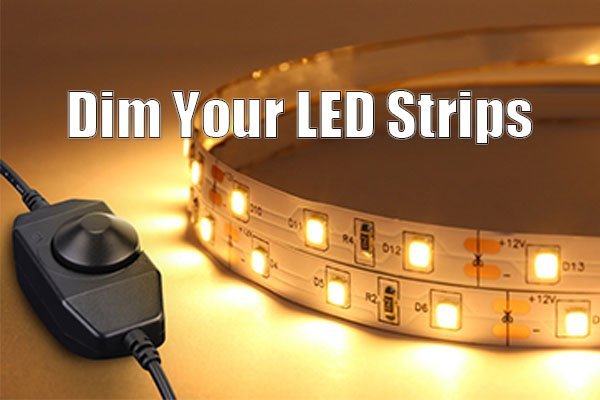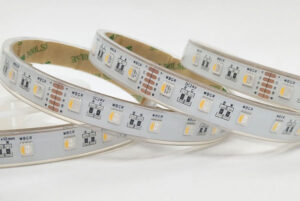LED strips are used in many places such as stores, hotels, billboards, entertainment venues, homes, and even in car decorations. One of the greatest challenges since the advent of LED lights is dimming. It is not only necessary to preserve the energy of a LED strip but also to increase the ambience and enhance the efficacy. All of these can be achieved by dimming your LED strips. This article will show you how to do that.
LED light engine types
Generally, there are two main determinants of dimming performance: the LED source and driver.
LED light engines are classified into two types: LEDs only and LED with a resistor or linear regulator.
LEDs only
If the LED light source or module consists of LEDs only, the conventional dimming approach is made by altering the amplitude of the current flowing into the LED. As a result, the LED driver should be developed to suit such a need. Just like Meanwell HLG families, Upowertek drivers have adjustable current and are regulated by an external dimmer using a DC1-10V* or 10V pulse width modulation (PWM) signal or simply a simple resistor.
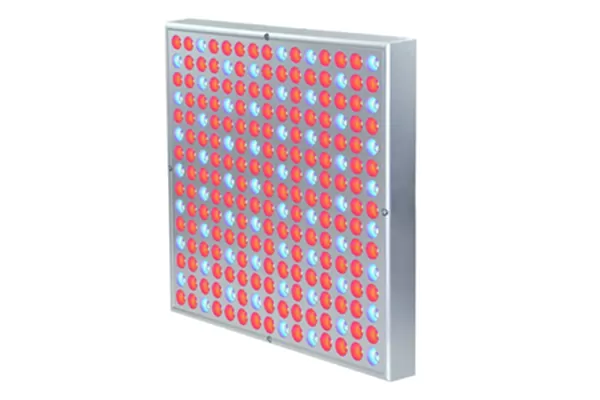

Download this page as a PDF
To save you time, we have also prepared a PDF version containing all the contents of this page, only leave your email and you will get the download link immediately.
LEDs with resistors
On the other hand, LEDs with resistors are commonly known as LED strips. They are popular because their current is reasonably constant due to a resistor in series with the LED. As a result, the user or installer may simply use any constant voltage source or LED driver to power the LED strip. LED strips are most commonly powered by either 12V or 24V. However, the process of constant voltage driver dimming is different from the constant current. And among the approaches employed in dimming an LED strip, using a signal dimmable LED driver is the best. At Upowertek, we provide signal dimmable LED drivers. This article demonstrates how to dim an LED strip using a signal dimmable LED driver with output PWM.
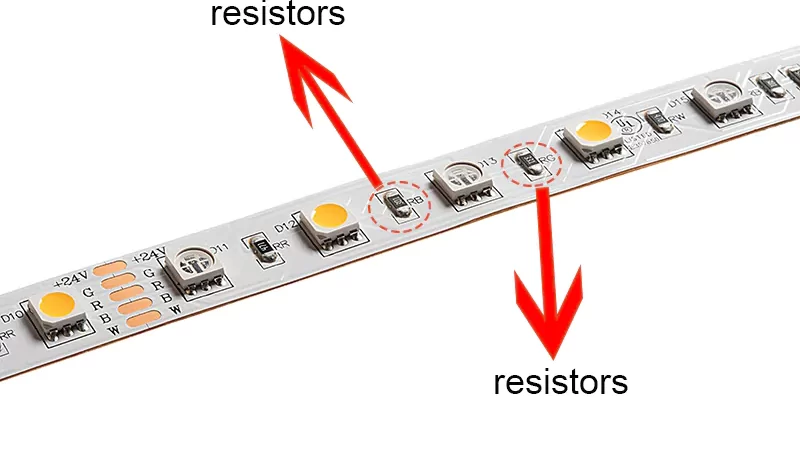
What are the Types of LED drivers?
A LED driver can be either a constant current or a constant voltage driver. The constant current LED drivers to have a fixed output current and a variable output voltage range. When the LED voltage changes, the current stays constant.
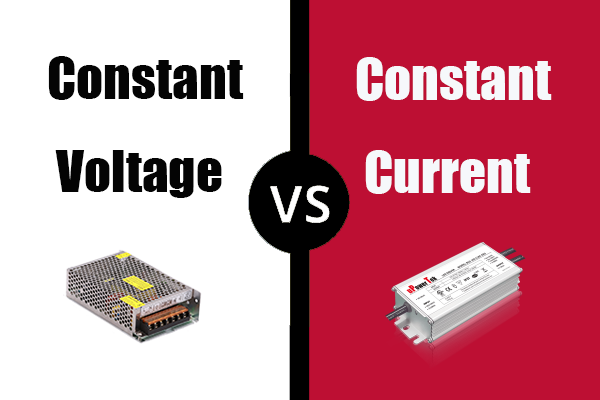
The constant voltage LED drivers, on the other hand, are only designed for all single DC output voltage. This type of driver maintains a constant voltage no matter how much current flows on it. Since LED strips usually have a current limiting resistor in series with the LED, only constant voltage drivers with PWM output are suitable to dim the strips as below shows.
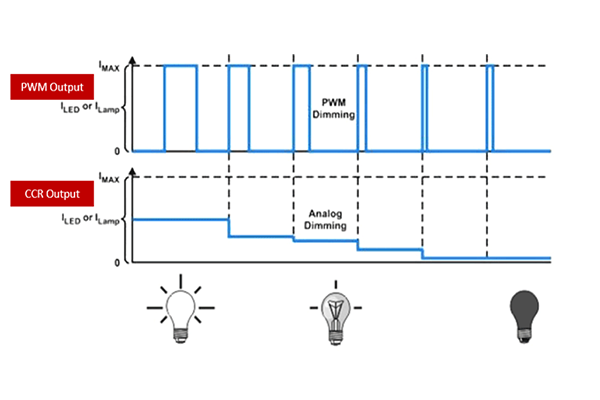
What is the best way to Dim an LED Strip Light?
When dimming your LED strips, you must use the proper power source and configuration. There are several techniques for dimming constant voltage LED strip lights. Each method has its advantages and disadvantages. In general, a non-dimmable (with an extra controller) or dimmable driver can be used to dim an LED strip light. While both solutions provide high-quality dimming, your decision may be dictated by your price and installation constraints.
Dimming using a non-dimmable light source
This approach is straightforward because it does not need any additional wiring. Dimming is accomplished on the DC side of the driver using a controller connected inline between the driver and the LED strip light.
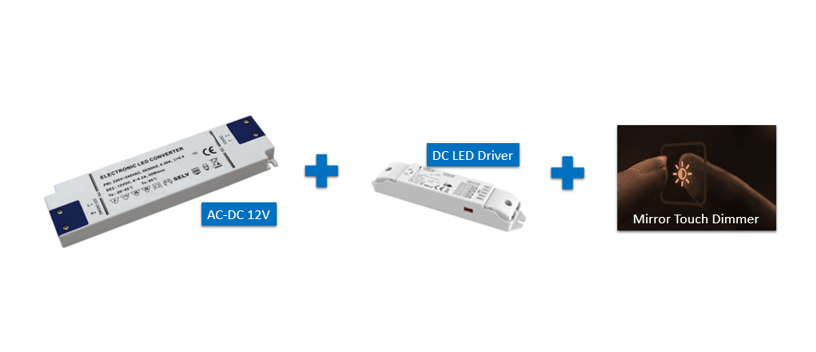
What are the pros and cons of dimming with a non-dimmable driver?
Non-dimmable drivers are often less expensive than dimmable drivers and easier to buy from the market. Additionally, the LED controller generates a consistent 0-100 percent range with no discernible flicker.
The disadvantage of this is that there is a need for a controller to operate with a non-dimmable driver.
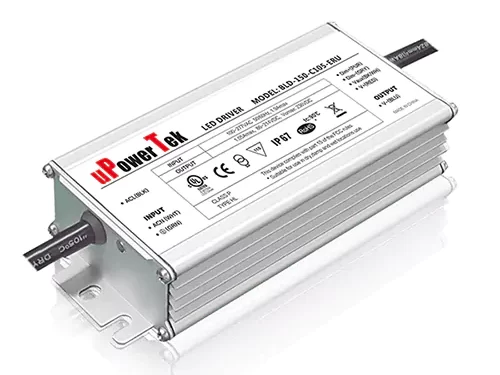
Dimming using a dimmable LED driver
There are two kinds of constant voltage dimmable drivers:
- Phase-cut dimmable LED drivers
- Utilizing a signal control in the driver’s control wires.
Phase-cut dimmable LED drivers
Typically, phase-cut or Triac dimmable drivers are used for this method. These drivers make use of a standard wallplate dimmer module, either leading edge or trailing edge module. You may accomplish this by attaching a typical rotary dimmer or a push button to a standard wallplate. Triac dimmers are commonly manufactured by Lutron, Leviton, Wallstopper, Honeywell, and Legrand.
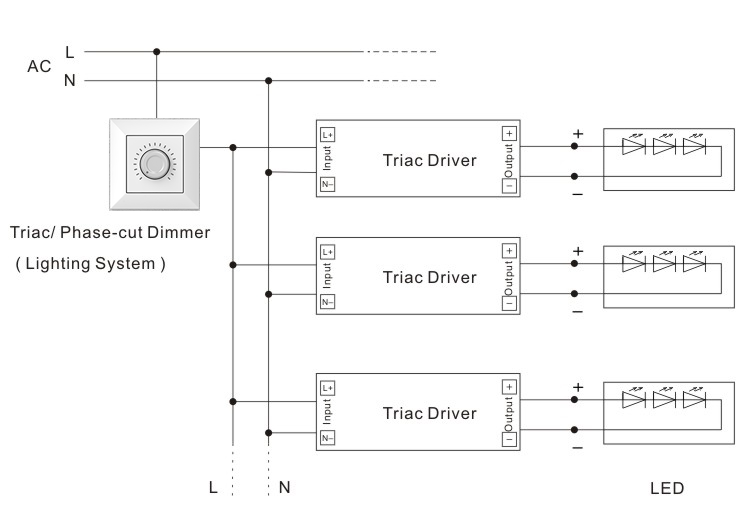
Using a wall dimmer necessitates a lot of wire and restricts the amount of load that can be handled. Phase-cut dimmers are applicable if the home already has a typical domestic dimming configuration; otherwise, this option can be pretty expensive.
What are the pros and cons of dimming on phase-cut dimmers?
The dimmer module attaches to the AC input side of the driver, so no additional wiring is required. As a result, it is perfect for upgrading older systems.
However, it is a costly procedure. There are also several brands of this driver on the market, making it difficult to choose a suitable one. Additional, these drivers can be loud and can interfere with other electrical drivers. Finally, it is often tough to locate a dimmer module that is ideal for every driver.
Signal input dimmable driver
The signal input which can be 0-10V or PWM signal dimmable driver is helpful for a variety of reasons. The dimming signal is carried by an extra pair of wires in these signal input dimmers. The signal uses a variety of protocols, including 0-10/1-10V, DMX, DALI, and a variable resistor. These signals can be connected to the driver through a pair of control wires separate from the DC output or AC input.

The 0-10V dimmer, which may be supplied with a rotary knob or a vertical slider, readily connects to the power supply’s two dimming wires. As a result, it gives your LED strip light, smooth, and effective dimming capabilities.
What are the pros and cons of a signal input dimmable driver?
Signal input dimmable drivers are lower cost. They also enable a versatile design with several home automation integrations.
However, they may not compatible with current systems because an additional pair of signal wires must be installed
Additionally, the driver must match the load by at least 90%.
Why do you need PWM Output LED Driver?
What exactly is PWM dimming?
PWM is an abbreviation for pulse width modulation. PWM has several applications, one of which is dimming and regulating LED lights. If you’re using a signal input dimmable driver, make sure the output is PWM. A PWM allows for a wide range of brightness by altering the amount of time the signal is ON or OFF. Unlike analog dimming, the PWM signal cannot be both ON and OFF at the same time. In other words, an LED will receive either full voltage or no electricity at all.
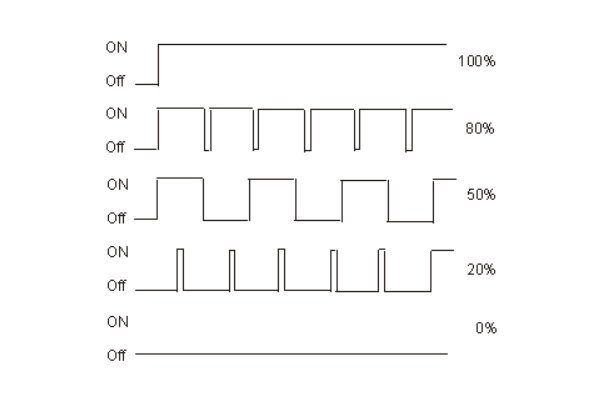
What is the significance of PWM output?
PWM dimming solves the challenge of load matching. This implies that you will always have constant and full-range dimming independent of the driver capacity and/or load. It also allows for equal dimming levels by using different size drivers controlled by the exact driver. This means that a 100W driver can operate an 80W load, and a 120W driver can work an 80W dimming at the same pace.
PWM not only achieves a lower dimming level, but also a much more accurate dimming for LED strips.
Comparison between using Constant Voltage and Constant Current driver
Colour temperature consistency
Most of the LED’s light feature changes with the operation current so engineers may have to choose PWM mode for the applications which are sensitive to colour temperature.

Accuracy
When designing a 10% dimmable light, most of the constant current mode driver accuracy is normally +/-3%, which means the real output at the 10% level can vary from 7%-13% (Upowertek driver does 9-11%). While PWM mode can do 1% min dimming level and also the variation range is from 0.95-1.05% which is not noticeable for human eyes.


Want to read it later?
To save you time, we have also prepared a PDF version containing all the contents of this page, only leave your email and you will get the download link immediately.
Current balance for each string
When the driver goes into the constant current mode, the current regulator of each LED string will not be able to regulate the current, so if there are multiple strings paralleled, we don’t know how much current there is in the strips.
The figure below shows the constant current dimming solution. The LEDs with linear regulators are driven by constant current drivers. Suppose we have to use a 250W driver to power six strips or signage modules with 700mA linear regulator each. The LED voltage is around 51V and 3V is the linear regulator voltage drop to make sure it works.
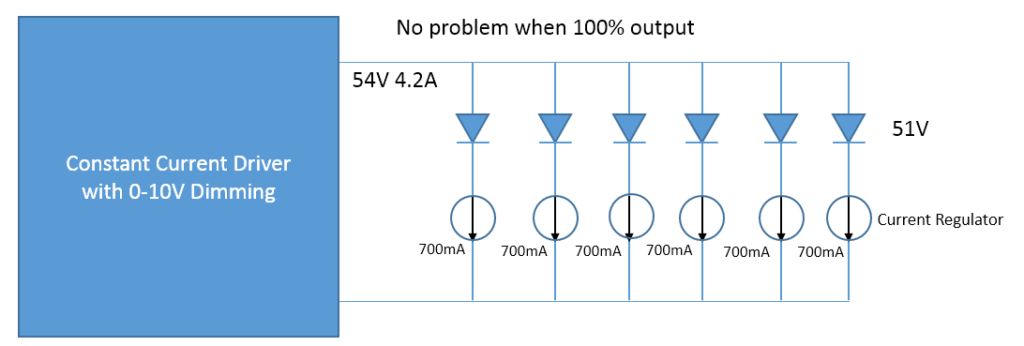
So it works well when the light is 100%.
Now let’s see what happens when we dim it down to for example 2.4A. To achieve a lower output current, the LED driver has to reduce the output voltage to around 52V, then the linear current regulator will not work and they are not able to regulate the current to 700mA at all, so the current will be imbalanced and we don’t know how much current there is for each string.
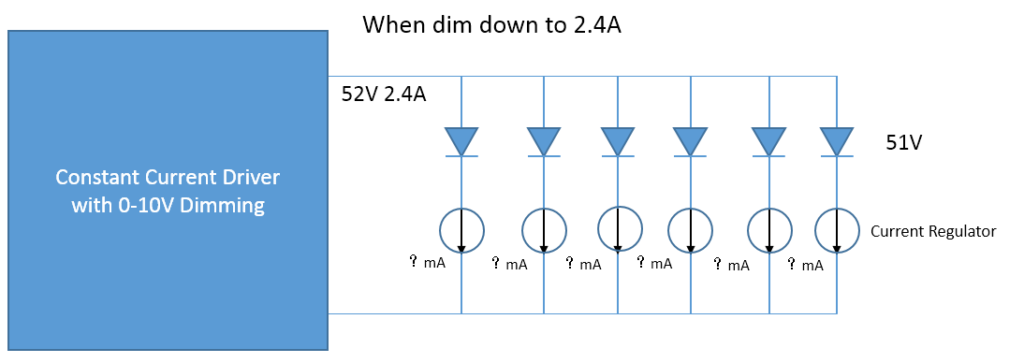
And most of the current solutions in the market can only dim to 10% as a minimum which is actually not low enough for most of the strip and signage applications.
The figure below shows Upowertek’s dimmable constant voltage driver working with the linear regulators. With this PWM dimming input, each string always works in a 700mA current and the difference between dimming levels is only the PWM duty cycle. The minimum dimming level can reach down to 2%. And that is able to meet most of the design targets.
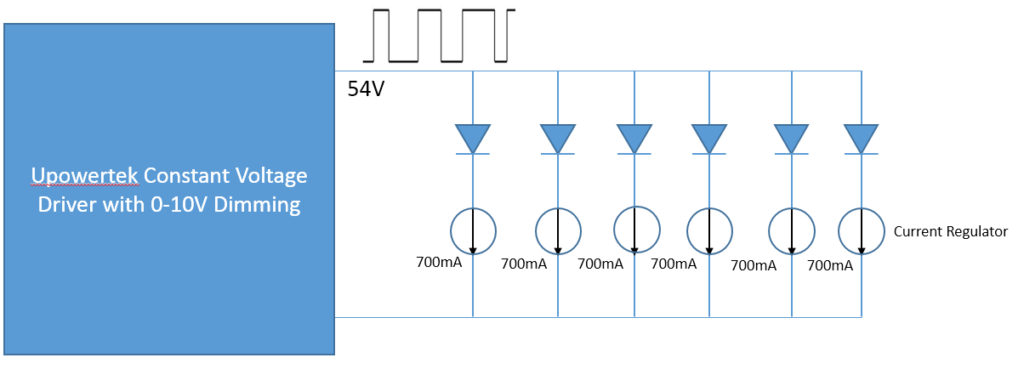
Dead Trip Issue
Compared with Meanwell’s HLG/ELG solutions, PWM dimming does not have any problems of “dead-travel or dead trip” of dimmers. For example, a 100W constant current driver drives a 100W LED strip, then there is no dead trip issue, however, in most of the common application, we may use a 100W driver to drive 70W strip for example, then the constant current driver output is 70W even though the dimmer output is higher than 7V until 10V thus the real adjustment range is 0-7V. If the load is smaller, the dead trip area is wider thus it makes dimming experience very unconfortable. But for a 100W PWM dimmable constant voltage driver, when the dimming voltage is 10V, the output of the driver is 70W as 100% load level and goes down linearly and smoothly with the dimming voltage until very low.
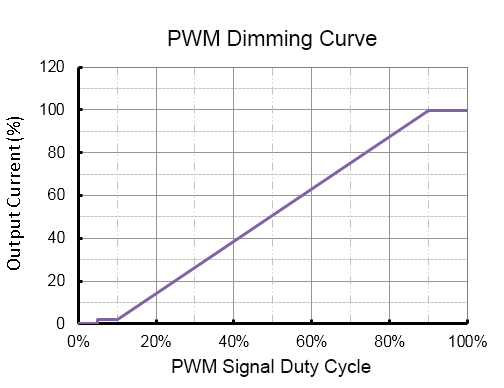
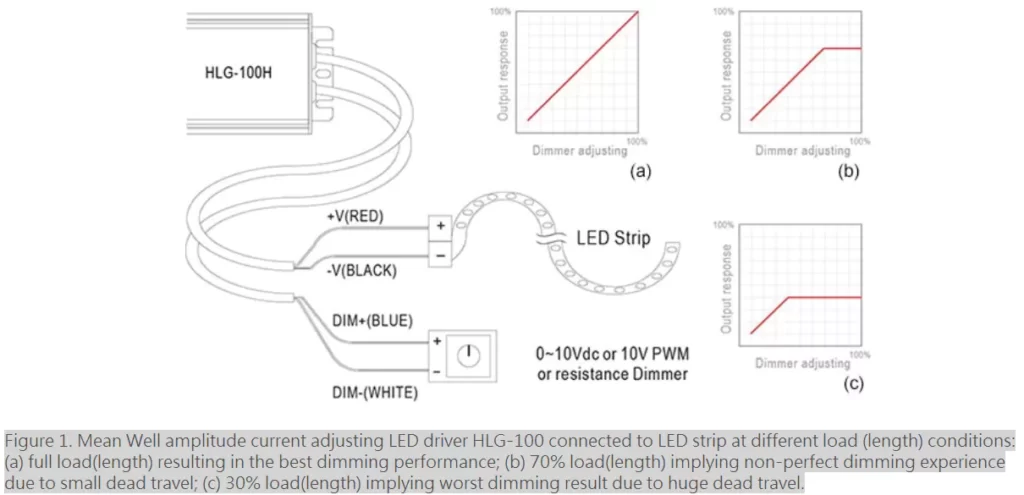
Conclusion
The effectiveness of LED dimming depends on the LED source and driver. Different methods could be used in dimming LED strips, with each having its pros and cons. A signal input dimmable driver is arguably the best at dimming LED strips due to its versatility and affordability. A PWM output is essential while using these drivers because it solves the challenge of load matching. If you’re itching to get quality signal input dimmable drivers, we are at your service. PWM mode constant voltage LED driver has great advantages over constant current mode and the cost does not add much. It is more suitable for applications where end-users have high and restricted requirements for the quality of the light. And Upowertek constant voltage drivers cover from 50-400W output power range and please contact us by to get the best quotation and service from Upowertek.

